Professional roadside assistance services in Minneapolis-Saint Paul provide 24/7 emergency battery jump start support for stranded motorists experiencing common warning signs like slow engine cranking, dashboard warning lights, or electrical system issues. Licensed technicians arrive equipped with commercial-grade jump start equipment and follow strict safety protocols when connecting cables to restore vehicle power. Services typically include proper cable connection, grounding procedures, and system verification to guarantee successful starts. Most providers offer rapid response times within 30-45 minutes and can diagnose underlying battery problems. Understanding the complete range of available services helps drivers make informed decisions during roadside emergencies.
Dead Battery Warning Signs
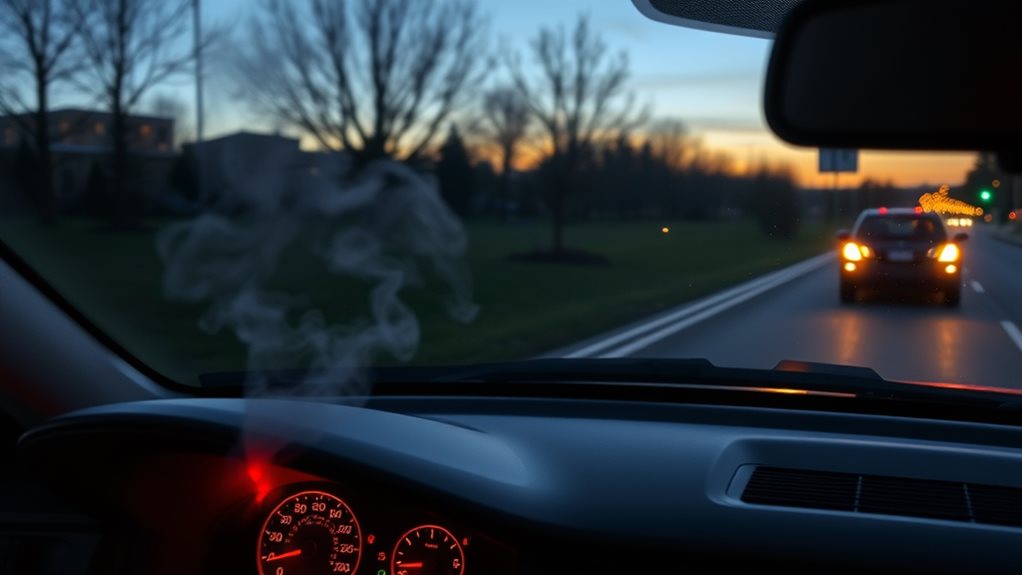
A failing car battery typically announces its deteriorating condition through several unmistakable warning signs, including an illuminated battery warning light on the dashboard and a noticeably slower engine cranking speed when starting the vehicle. The electrical system may exhibit erratic behavior, such as dimming headlights, malfunctioning power windows, or inconsistent operation of the car’s accessories, which often indicates the battery’s diminishing capacity to maintain proper voltage. A clicking sound when starting is another clear indicator that your battery may be failing. These symptoms, particularly when occurring simultaneously, strongly suggest that the battery is approaching the end of its service life and requires immediate attention to prevent unexpected failure. In such cases, having access to experienced technicians for a quick diagnosis and possible jump start becomes crucial.
Dashboard Warning Light Indicators
When a vehicle’s battery dies and is subsequently jump-started, multiple dashboard warning lights typically illuminate, indicating various system disruptions. These warning indicators occur because the vehicle’s computer system temporarily loses power, triggering various fault codes across multiple systems. In cases where the battery voltage drops significantly, electrical system malfunctions can occur. Understanding these warning lights helps diagnose potential issues and guarantee proper system restoration.
Common dashboard warning lights after a dead battery include:
- ABS and brake system indicators, which may remain illuminated until codes are cleared
- Electronic stability control and traction control warning lights due to voltage irregularities
- Power steering and collision mitigation system indicators resulting from system resets
- Tire pressure monitoring system warnings, even when tire pressures are within normal range
These warning lights typically resolve after clearing the codes with an OBD-II scanner or after driving the vehicle for several minutes.
Slow Engine Cranking Speed
Before dashboard warning lights illuminate, drivers often experience clear signs of a failing battery through slow engine cranking speed. When turning the key in the ignition, a sluggish or prolonged cranking sound indicates potential battery deterioration, though several underlying factors may contribute to this issue.
While a weak battery is frequently the culprit, voltage drops in the main power cable, corroded terminals, or loose connections can similarly impair starting performance. Starter corrosion can significantly affect cranking speed even with a healthy battery.
Professional diagnostic testing is essential, as slow cranking may stem from parasitic current draw, faulty alternator output, or compromised wiring integrity. Weather conditions, particularly cold temperatures, can exacerbate these symptoms by reducing battery efficiency. Addressing slow cranking promptly through proper testing and maintenance can prevent complete battery failure and the subsequent need for emergency assistance.
Unusual Electrical System Behavior
Recognizing unusual electrical system behavior serves as a critical early warning system for battery failure. When vehicle electronics begin exhibiting irregular patterns, it often indicates an underlying battery issue that requires immediate attention to prevent complete system failure and potential roadside emergencies.
Common indicators of electrical system irregularities include:
- Dimming or flickering headlights, particularly when the engine is idling or multiple accessories are in use
- Intermittent functionality of power windows, heated seats, and electronic components
- Dashboard warning lights that illuminate sporadically or display erratic behavior
- Inability to charge mobile devices through the vehicle’s USB ports despite proper connection
These symptoms, especially when occurring simultaneously, strongly suggest diminished battery capacity or charging system complications. Professional diagnosis can determine whether the battery requires replacement or if other electrical components need attention. The radio not powering on when turning the key to the ON position is a common weak battery symptom that should not be ignored.
Reliable Jump Start Services Near You
Professional auto battery jump start services are available 24/7 to assist motorists experiencing battery-related emergencies. Certified technicians arrive equipped with specialized tools and equipment, offering response times ranging from 15-90 minutes depending on location. Our jump-start services adhere to eco-friendly practices, aligning with sustainability initiatives. The service includes complimentary battery testing, expert troubleshooting, and professional jump starts without traditional jumper cables. Our rotten egg smell from your battery could indicate dangerous sulfur gases and requires immediate attention from a professional. Customers can access these services through convenient website or mobile app bookings, with transparent pricing starting from $25-$75 depending on the service provider and location. Additional automotive services, including battery delivery, installation, and car door opening, are also available to address various roadside needs.
Benefits Of Hiring A Local Roadside Assistantace For Jump Start Your Car
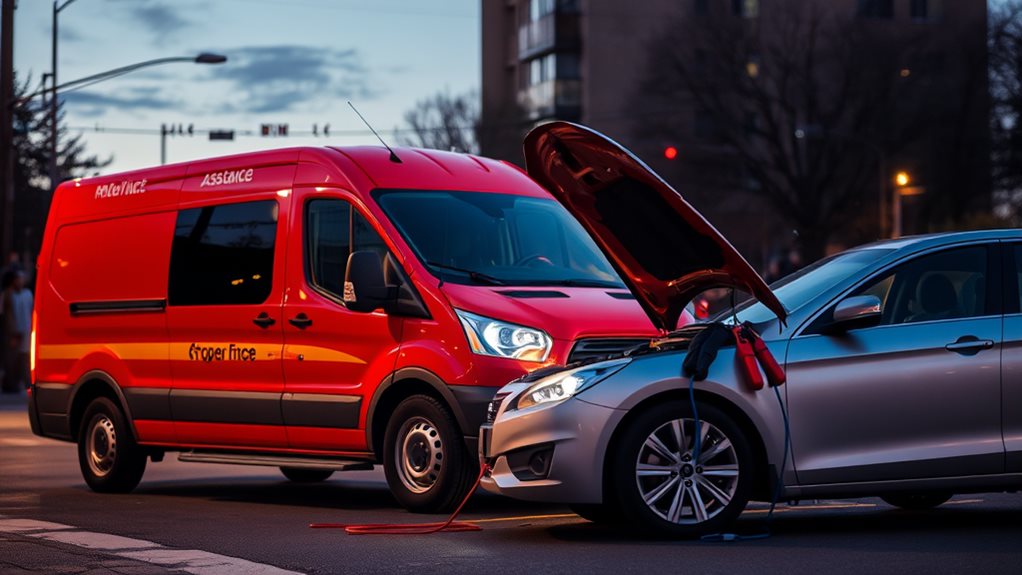
Local roadside assistance providers deliver rapid response times for emergency jump-start situations, typically arriving within minutes to minimize disruption and stress during vehicle battery failures. These services offer convenient and reliable solutions to avoid the hassle of pushing or replacing the battery. Professional technicians come equipped with industrial-grade jump starters and diagnostic tools, ensuring safe and effective battery revival while protecting your vehicle’s sensitive electronic systems. Their expertise not only addresses immediate battery issues but also helps prevent potential damage that could occur from improper jump-start procedures or underlying electrical system problems. The round-the-clock availability of local services ensures motorists can get help at any hour, day or night.
Fast Emergency Response Time
Three critical advantages make fast emergency response times a compelling reason to hire local roadside assistance for jump-starting your car. Professional providers utilize advanced technology and established networks to guarantee rapid deployment of assistance when drivers need it most. Their thorough systems enable efficient service delivery through:
- 24/7 availability with technicians ready to respond at any hour, typically arriving within 30-60 minutes
- Real-time GPS tracking capabilities that precisely locate stranded vehicles and monitor service provider arrival
- Streamlined digital request processes through mobile apps and online platforms, reducing response initiation to mere minutes
- Multiple communication channels, including phone, app, and digital assistant options, ensuring accessibility regardless of circumstances
This systematic approach to emergency response demonstrates the industry’s commitment to minimizing vehicle downtime and maximizing customer safety and satisfaction. Members can receive discounted battery replacements if the jump start reveals more serious electrical issues.
Expert Equipment and Tools
The advanced equipment and specialized tools employed by roadside assistance providers represent a significant advantage over consumer-grade alternatives. Professional services utilize high-capacity jump starters like the Jump-N-Carry JNC325 and Green Keeper series, specifically designed for various vehicle types, including hybrid and electric models. These units feature precise Cold Cranking Amps ratings and built-in safety mechanisms to prevent electrical damage. Since modern hybrid and electric vehicles require extra precaution, technicians wear insulated safety gear when performing jump starts.
Professional equipment includes extended cable lengths, curved clamps for better battery access, and integrated safety features that protect both vehicles and operators. The sophisticated tools are regularly maintained and calibrated to manufacturer specifications, ensuring ideal performance across different vehicle types. Additionally, these professional-grade units often incorporate supplementary features such as LED lighting systems and multiple charging capabilities, enabling technicians to address various roadside scenarios efficiently and safely.
Prevent Further Battery Damage
Professional roadside assistance services excel at preventing additional battery damage during jump-start procedures through proven safety protocols and expertise. Their meticulous approach guarantees both vehicle and battery safety while minimizing potential risks to electrical systems. They carefully follow manufacturer-specified procedures and utilize professional-grade equipment to protect your investment. They always wear splash-proof Z-87 goggles while handling batteries to ensure eye protection.
Technicians perform thorough battery inspections for signs of damage, corrosion, or leakage before initiating any jump-start procedure. They maintain precise cable connection sequences and proper grounding techniques to prevent electrical system damage. Qualified professionals monitor voltage levels during the charging process to prevent alternator strain. Teams guarantee adequate post-jump-start runtime and verify proper charging system operation.
These preventive measures drastically reduce the likelihood of subsequent battery failures and protect your vehicle’s sensitive electronic components, ultimately saving you from costly repairs and replacements.
Jump Start Safety Guidelines
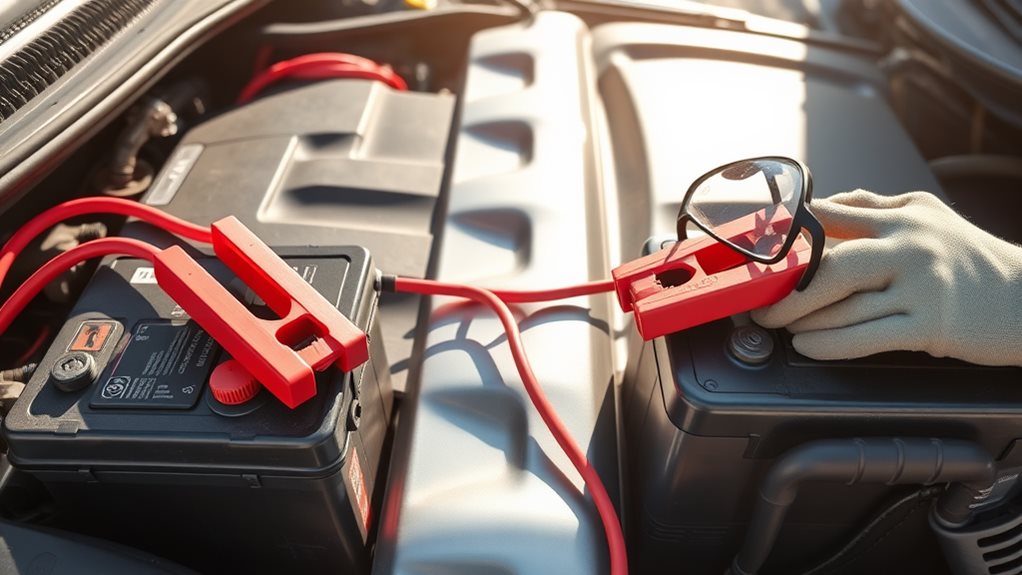
Performing a safe jump start requires having the appropriate equipment, including properly rated jumper cables and personal protective gear such as safety glasses and gloves. Following established safety protocols means systematically connecting the cables in the correct sequence: positive to dead battery, positive to booster battery, negative to booster battery, and finally negative to an unpainted metal surface in the vehicle with the dead battery. It is essential to set parking brakes on both vehicles before beginning the jump-start process. Maintaining strict adherence to these fundamental safety guidelines not only protects the vehicles’ electrical systems but also safeguards individuals from potential electrical hazards and battery acid exposure during the jump start procedure. Many residents in the region regard the Twin Cities metropolitan area as offering reliable roadside services, ensuring peace of mind during car troubles.
Proper Equipment and Tools
When selecting equipment for jump-starting a vehicle, safety and compatibility must be the primary considerations. Professional-grade jump starters should incorporate multiple protection features, including reverse polarity, overcharge, and short circuit safeguards, while maintaining sufficient power output for the specific vehicle’s requirements. NOCO Genius series jump starters offer reliable lithium-powered solutions ranging from 400A to 3000A to match different vehicle needs.
Essential equipment components for safe and effective jump-starting include:
- Compatible jump starter with appropriate amperage rating for the vehicle’s engine size
- Heavy-duty, insulated jumper cables with secure, corrosion-resistant clamps
- Protective carrying case for proper storage and transportation
- Multi-feature diagnostic indicators to confirm proper connection and operation
Additionally, consider jump starters with supplementary features such as LED lighting and USB ports, which can prove invaluable during roadside emergencies. The equipment should be regularly inspected and maintained according to manufacturer specifications to guarantee reliability when needed.
Personal Protection First
Safety equipment forms the first line of defense when jump-starting a vehicle. Professional technicians prioritize personal protection by wearing properly insulated gloves to prevent electrical shock and utilizing appropriate eye protection against potential battery acid exposure or sparks. It’s imperative to remove all metallic jewelry, particularly rings and watches, which could create dangerous short circuits during the jump-starting process. Visual inspection checks must be performed on jump starters before each use to ensure there’s no damage that could compromise safety.
Before initiating any battery service, thorough inspection of safety gear guarantees ideal protection. The gloves must be free from tears or wear, while safety glasses or goggles should provide complete eye coverage without scratches or damage that could impair visibility. This meticulous attention to personal protection equipment not only safeguards the technician but also assures a secure and professional jump-start service for the customer.
Follow Correct Connection Order
The success of a battery jump-start hinges on following a precise connection sequence that minimizes safety risks and protects vehicle electronics. Proper cable connection order is critical for preventing electrical system damage and ensuring operator safety during the jump-start procedure. Protective eyewear is essential due to potential battery explosions or discharge.
- Connect the positive (red) cable to the positive terminal of the dead battery, then attach the other end to the positive terminal of the booster battery
- Attach the negative (black) cable to the negative terminal of the booster battery
- Connect the remaining end of the negative cable to an unpainted metal surface in the engine bay of the disabled vehicle
- After successful start-up, remove cables in exact reverse order, maintaining careful handling to prevent electrical arcs
This systematic approach safeguards both vehicles’ electrical systems while providing the necessary power transfer to restart the disabled vehicle efficiently.
Connect With A Team Member Today!
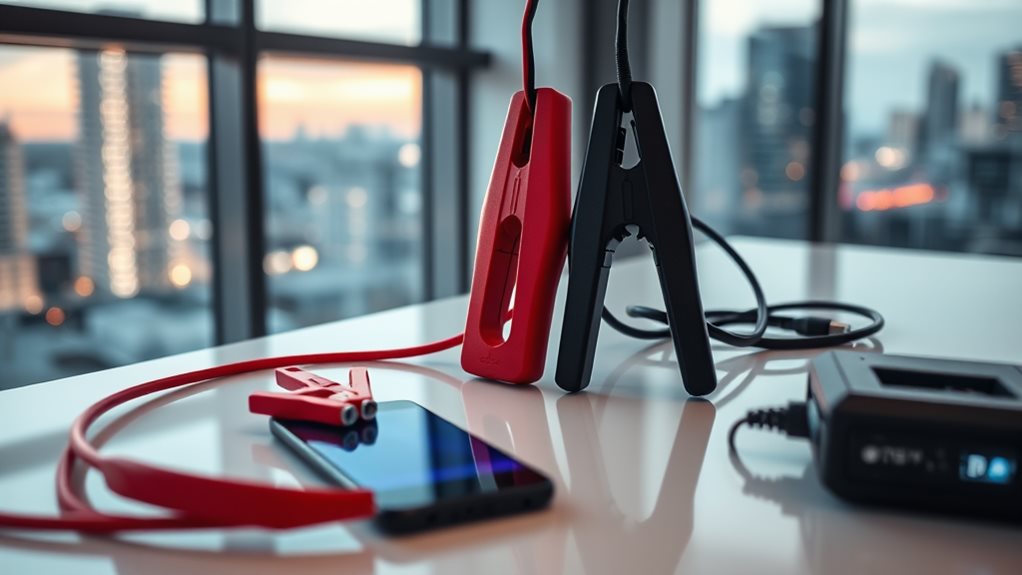
Don’t let a dead battery leave you stranded. Our professional technicians are ready to help anytime, anywhere with:
- Instant online booking through our website or mobile app
- Real-time tracking of your technician’s arrival
- Free battery testing and expert advice
- No membership fees or hidden costs
- Service at your location – home, work, or roadside
Our reliable jump start service ensures that you have the appropriate equipment and receive prompt assistance wherever you are.
Book now through our website or call our customer support team for immediate assistance. We’ll get you back on the road quickly and safely!
☎️ Available 24/7
💻 Easy online booking
🚗 Fast response times
💰 Transparent pricing
📍 GPS-enabled service
Additional Information About Minneapolis-Saint Paul MN
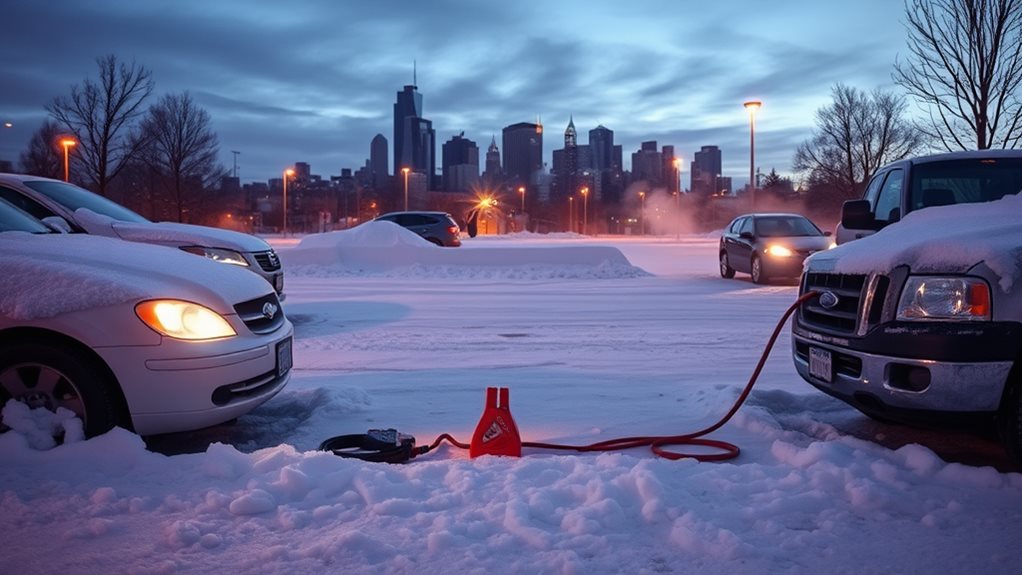
Minneapolis-Saint Paul, known as the Twin Cities, represents a vibrant metropolitan area where St. Paul, with its population of 303,820, showcases a diverse demographic composition. The city maintains a solid educational foundation, with 88.2% of residents holding high school diplomas and 42.8% possessing bachelor’s degrees or higher.
St. Paul’s infrastructure encompasses 56 square miles of urban landscape, featuring over 4,000 acres of parks and 100 miles of trails. The Mississippi River banks provide a natural boundary for many of these recreational areas. The housing market reflects stability with a median home value of $264,900, while the owner-occupancy rate stands at 53%. Residents experience reasonable commute times averaging 24.8 minutes, supported by extensive transportation networks.
The metropolitan area’s robust economy is evident in its median household income of $94,673, positioning the Twin Cities as a significant economic center in the Upper Midwest.
Nearest Cities In Minneapolis-Saint Paul MN
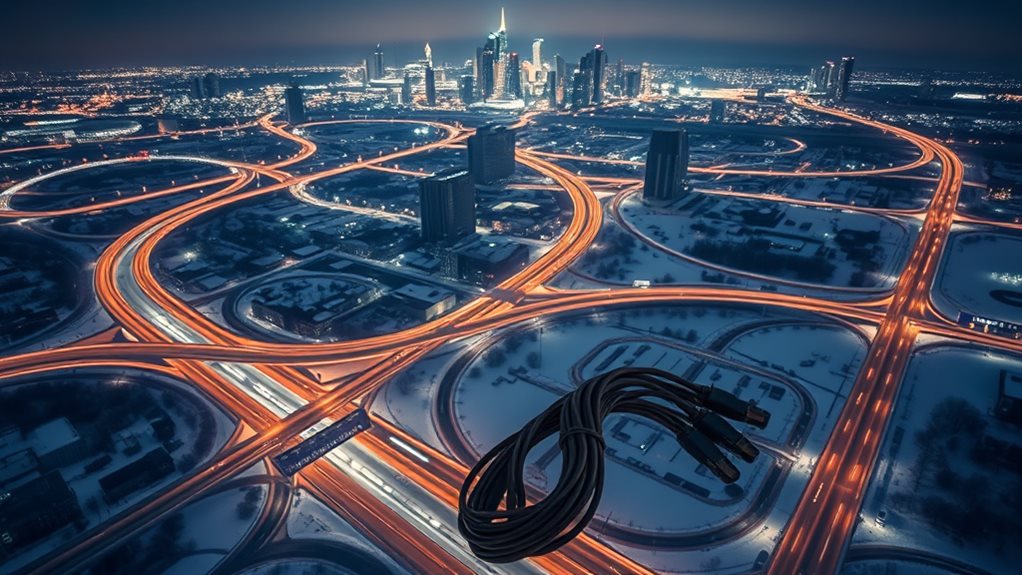
Surrounding the vibrant metropolitan area of Minneapolis-Saint Paul are several cities that contribute to the region’s economic, cultural, and social fabric. These cities are integral to the broader Twin Cities area and often require similar services, including auto battery jump start services.
Here are some of the nearest cities:
- Bloomington: Known for its retail and commercial activities, residents here may need jump start services due to heavy vehicle usage.
- Eagan: With its growing population and busy roads, Eagan residents might require emergency jump starts or scheduled maintenance.
- Roseville: This city, located between Minneapolis and St. Paul, benefits from the same roadside assistance services available in the twin cities. Residents in Roseville can also rely on Expert Technicians for efficient and safe jump start assistance.
- Shakopee: As a suburban city with a mix of residential and commercial areas, Shakopee residents can rely on local jump start services for their vehicles.
These cities are well-served by companies like DRIVE Roadside, Smitty Big Towing, Twin Cities Transport & Recovery, and St. Paul Towing Service.
Local Seasonal Weather In Minneapolis-Saint Paul MN
The Minneapolis-Saint Paul metropolitan area experiences a diverse range of seasonal weather patterns, each with its own unique characteristics and potential impacts on vehicle performance.
In winter, the region is characterized by extremely cold temperatures, with January being the coldest month and average lows often below 32°F. Snowfall is significant, with over 54 inches annually, and wind chill values can be dangerous due to arctic air masses and strong winds.
Spring brings a rise in temperatures and precipitation, with common thunderstorms from March to November. Summer is warm and humid, with high heat indices and significant rainfall, while autumn sees cooling temperatures and a decrease in precipitation.
Understanding these seasonal variations is indispensable for maintaining vehicle health and preparing for potential battery issues.
FAQ
Can Jumping a Car Battery Damage My Car’s Computer System?
Yes, improper jump-starting can damage your car’s computer system (ECU) through power surges or reversed polarity. Using correct procedures and quality jumper cables greatly reduces these risks and protects essential electronic components.
How Long Should I Let My Car Run After a Jump Start?
After a jump start, run your vehicle for at least 30 minutes to properly recharge the battery. For ideal results, drive the car rather than idling, as this helps the alternator charge more effectively.
What’s the Average Response Time for Emergency Battery Jump Start Services?
Professional emergency battery jump start services typically respond within 30 minutes, depending on traffic conditions. Our technicians prioritize quick responses to minimize your wait time and get you back on the road safely.
Will My Car Insurance Cover Professional Jump Start Assistance?
Standard auto insurance typically doesn’t cover jump-start services. However, if you’ve added roadside assistance coverage to your policy, professional jump-start assistance is usually included. Check your specific policy details for confirmation.
Can I Jump Start My Car if It Has a Hybrid Battery?
Yes, you can jump-start a hybrid car when its 12-volt battery is discharged. Follow the standard jump-start procedure, but be sure to consult your owner’s manual as specific hybrid models may have different connection points.
